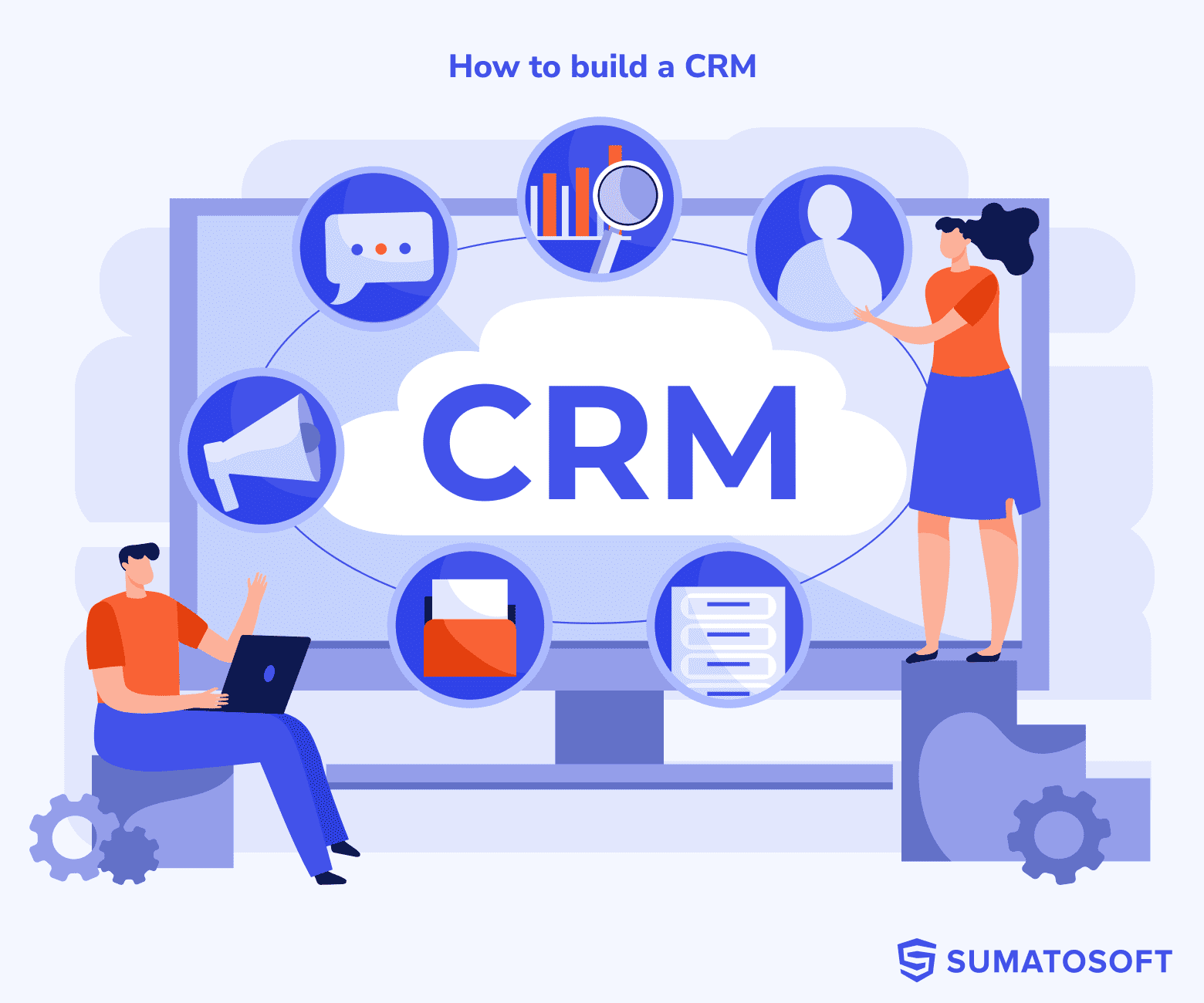Software Development Team Structure: Everything You Need to Know


As technology continues to revolutionize how we live and work, the field of software development has not only gained significant attention but has also grown exponentially. The U.S. Bureau of Labor Statistics forecasts a remarkable growth of 25 percent in demand for developers, quality assurance analysts, and testers from 2023 to 2031. Yet, as these roles grow in demand, their effectiveness largely depends on one critical factor: the structure of the software development team. We tell it as an experienced custom software development company that has provided software development services for 10 years for now.
This article offers a deep dive into what makes a successful software development team, the different models of team structure, and how to navigate the challenges posed by team dynamics. By understanding the importance of a well-structured team, we can better equip ourselves to meet the rising demands of the industry and usher in a new era of innovation.
- Project management styles in the teams: the difference between traditional and agile approaches.
- 3 team structures: generalists, specialists, hybrids.
- Roles and responsibilities within the team: we describe specialists like product manager, project manager, team lead, tech lead, designers, business analysts, etc.
- How to build your software development team.
What Is A Software Development Team?
Put simply, a software development team is a group of people who work together to build software for your business. This could be an app for your customers, a bespoke company website, or a specialized program for internal use, such as inventory management or a CRM system. You may choose to build an in-house development team or outsource your software development through an external provider. To compare the pros of cons of both approaches, read our article on outsourcing vs in-house development.
A successful software development team structure should always resemble that of a well-oiled machine. Each team member should make a valuable contribution to the project’s final outcome, and dead weight should be minimized. Development teams will also need to choose a style of project management, which typically falls under one of two categories — traditional or agile. These can be defined as:
Traditional
- A rigid, hierarchical structure.
- The project manager is solely responsible for delivering a high-quality end product to the Client.
- If a Client’s needs change the entire project may be reevaluated, and alterations will be suggested by the Client.
- Teams are usually large, and the primary focus is on well-defined processes.
- The application development lifecycle is linear.
Agile
- Lacks a rigid, hierarchical structure.
- Prioritizes job-relevant skills over employment history or professional experience.
- Focuses on clear communication between team members and departments.
- Team members are tasked solely with building software products. Specialists may suggest alterations and make high-level decisions.
- Every team member bears equal responsibility for the end product. The project manager is responsible for removing any obstacles, coordinating the team, and communicating with Clients.
- Requires understanding of some Agile concepts like story points in agile, release planning, iterative development lifecycle, sprints, retrospective, etc.
Once you’ve decided on the overarching approach of your team’s management, you can dig into the details of how you’ll construct your team. Here’s an overview of three common types of software development team structures you might find on the market.
Software Development Team Structures
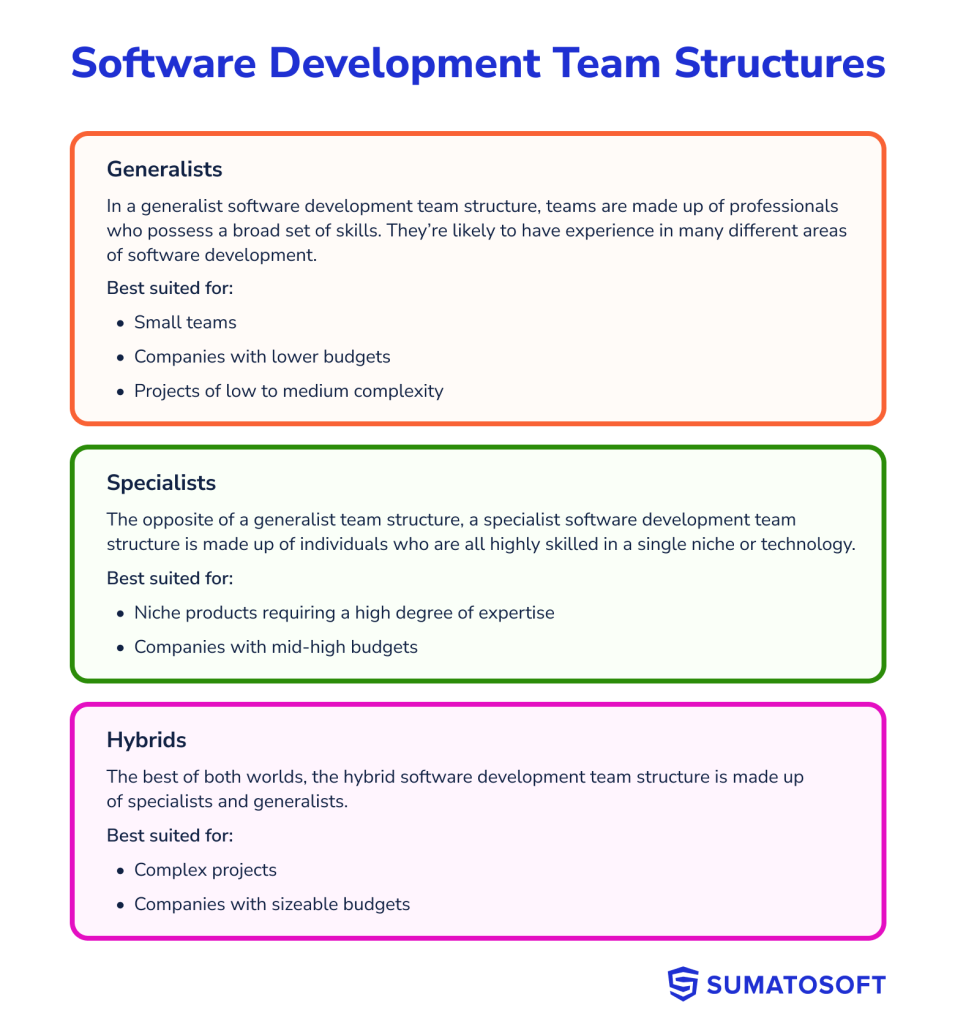
As we dive deeper into the world of software development team structures, we will examine three common types: Generalists, Specialists, and Hybrids. Each structure has unique characteristics that make them ideally suited to different types of projects, organizations, and budget constraints. Understanding these distinctions is crucial for assembling the right team for your specific needs, ensuring that your project not only reaches completion but excels in quality and efficiency. So let’s explore these three software development team structures and determine when and where to utilize each for maximum effect.
Generalists
In a generalist software development team structure, teams are made up of professionals who possess a broad set of skills. They’re likely to have experience in many different areas of software development. Think of them as the Swiss army knife of software development squads — competent at most tasks, but often lacking the specialist expertise and experience needed to tackle particularly niche or complex projects.
Best suited for:
- Small teams
- Companies with lower budgets
- Projects of low to medium complexity
Specialists
The opposite of a generalist team structure, a specialist software development team structure is made up of individuals who are all highly skilled in a single niche or technology. This structure is likely to result in a high-quality end product; however, communication gaps may crop up if problems arise. Therefore, it’s crucial to equip your team with an experienced project manager to eliminate any roadblocks.
Best suited for:
- Niche products requiring a high degree of expertise
- Companies with mid-high budgets
Hybrids
The best of both worlds, the hybrid software development team structure is made up of specialists and generalists. Overall, hybrid team structures are the most popular way of organizing software developers, but again, communication can be an issue. It may be challenging for those possessing a more broad knowledge of the project to understand a specialist’s approach, and this could cost your company time and money in the long run.
Best suited for:
- Complex projects
- Companies with sizeable budgets
What Are The Roles Within A Development Team?
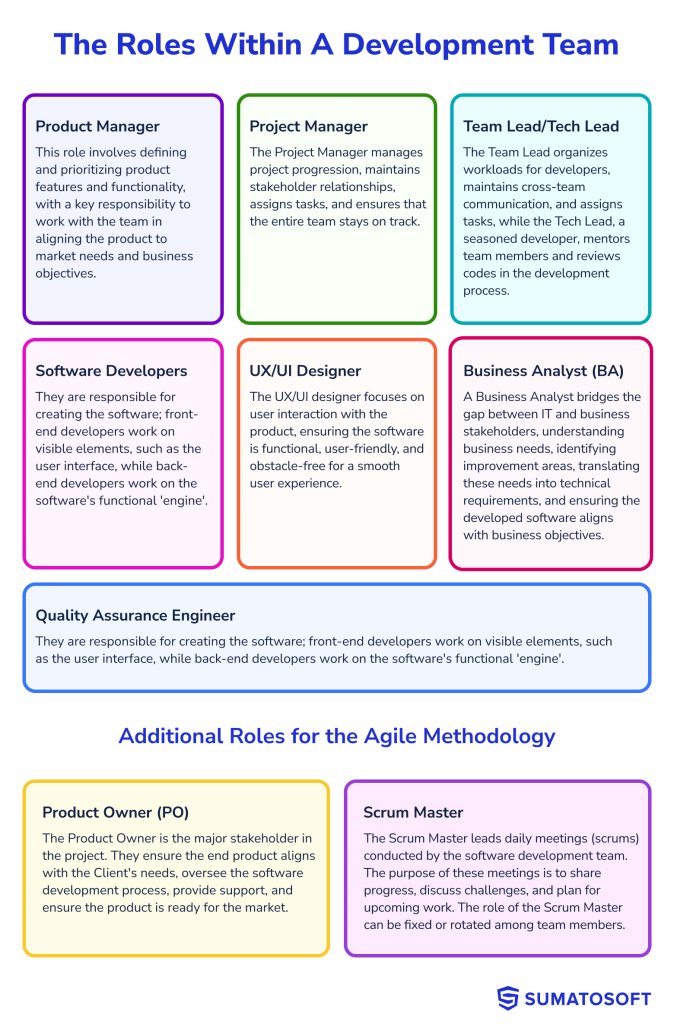
It could be confusing to understand all roles within the software development team. 18 is the number of different types of software developer jobs! So, let’s try to understand how two teams look like: those who follow the traditional software development model and agile. The Agile methodology requires some additional specialists in the team. Let’s start with classic specialists:
Product Manager
Responsible for defining and prioritizing the features and functionality of the product. They work closely with the entire development team to ensure that the product meets the needs of the target market and aligns with the company’s overall business goals.
Project Manager
The PM is responsible for keeping track of the project’s progress. Additionally, PMs must manage relationships among stakeholders and various other departments within the business. They oversee all processes, assign tasks, provide updates to the Client, and ensure that every team member stays on track to complete the project.
Team Lead/Tech Lead
Team leaders are responsible for organizing your developer’s workloads, maintaining cross-team connections, and allocating tasks. Tech leads are highly-experienced developers, responsible for mentoring other team members, and reviewing code before it moves on through the development pipeline. The two can often be confused with each other, and we’ll cover this later on.
Software Developers
The people are responsible for building the software. Front-end developers code the visible elements, such as the user interface, whereas back-end developers work on the ‘engine’ of the software — the code that drives the software’s functionality. In general, there are a lot of roles for software developers. We described them in detail in our article types of software developers jobs.
UX/UI Designer
These people are responsible for the way in which end-users will interact with the final product. Their core goal is to ensure that the software is functional and user-friendly, minimizing obstacles and creating a frictionless user experience.
Business Analyst (BA)
A Business Analyst (BA) plays a pivotal role in bridging the gap between IT and business stakeholders in a software development team. They are primarily responsible for understanding the business needs, identifying areas for improvement, and translating these needs into detailed technical requirements. The BA interacts with various stakeholders to gather, analyze, and document the requirements and processes, and uses this data to guide the software development team. They also play a critical role in validating solutions against business needs, ensuring that the developed software aligns with the objectives of the business and offers the desired value. By acting as a liaison between non-technical stakeholders and the technical team, a Business Analyst is essential in creating efficient, effective, and high-value software solutions.
Quality Assurance Engineer
A QA Engineer’s job is to test the product’s functionality to ensure that the end product reaches the Client in a complete and glitch-free state. Think of them as the final editor of the entire development process — they’re there to cross the t’s and dot the i’s. If an error is detected, the QA will alert the rest of the team so that it may be fixed before the final release.
If you decide to use an agile scrum methodology, your software development team structure may have some additional roles.
Additional Roles for the Agile Methodology
Product Owner (PO)
The major stakeholder of the project. It’s the PO’s responsibility to ensure the end product perfectly matches the Client’s needs. The PO oversees the entire software development process, provides support, and ensures the product is market-ready. This
Scrum Master
Scrums are daily meetings conducted by the software development team. The aim of a good scrum is to convene, share progress, discuss any challenges, and plan for the work ahead. It’s the Scrum Master’s job to lead the meeting. Some teams have a fixed Scrum Master, while others alternate the role with various team members occupying the position on different days.
How many roles are there in the average software development team? It’s an impossible question to answer! Every project will have its own unique set of needs, so the size of your team (as well as the roles within it) is entirely up to you.
Technical Lead vs Team Lead — What’s The Difference?
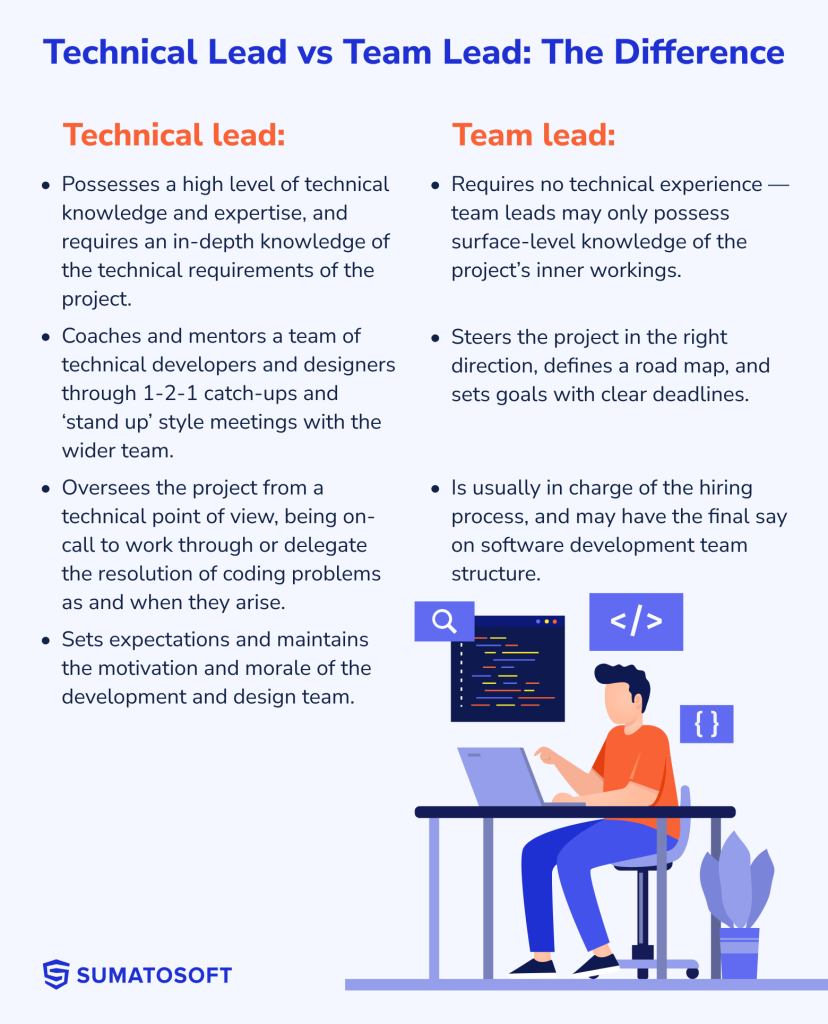
While completely necessary, the lack of standardization when it comes to job titles can be inherently confusing, especially for those outside your chosen industry. Tech lead and team lead are two completely different roles, but they’re the subject of much confusion, so let’s clarify their definitions:
Technical lead:
- Possesses a high level of technical knowledge and expertise, and requires an in-depth knowledge of the technical requirements of the project.
- Coaches and mentors a team of technical developers and designers through 1-2-1 catch-ups and ‘stand up’ style meetings with the wider team.
- Oversees the project from a technical point of view, being on-call to work through or delegate the resolution of coding problems as and when they arise.
- Sets expectations and maintains the motivation and morale of the development and design team.
Team lead:
- Requires no technical experience — team leads may only possess surface-level knowledge of the project’s inner workings.
- Steers the project in the right direction, defines a road map, and sets goals with clear deadlines.
- Is usually in charge of the hiring process, and may have the final say on software development team structure.
Remember, job titles are discretionary, and every team is different. Both a technical and team lead may be necessary for one project, whereas a single role encompassing all of the above responsibilities may be better suited for another.
Product Manager vs Product Owner
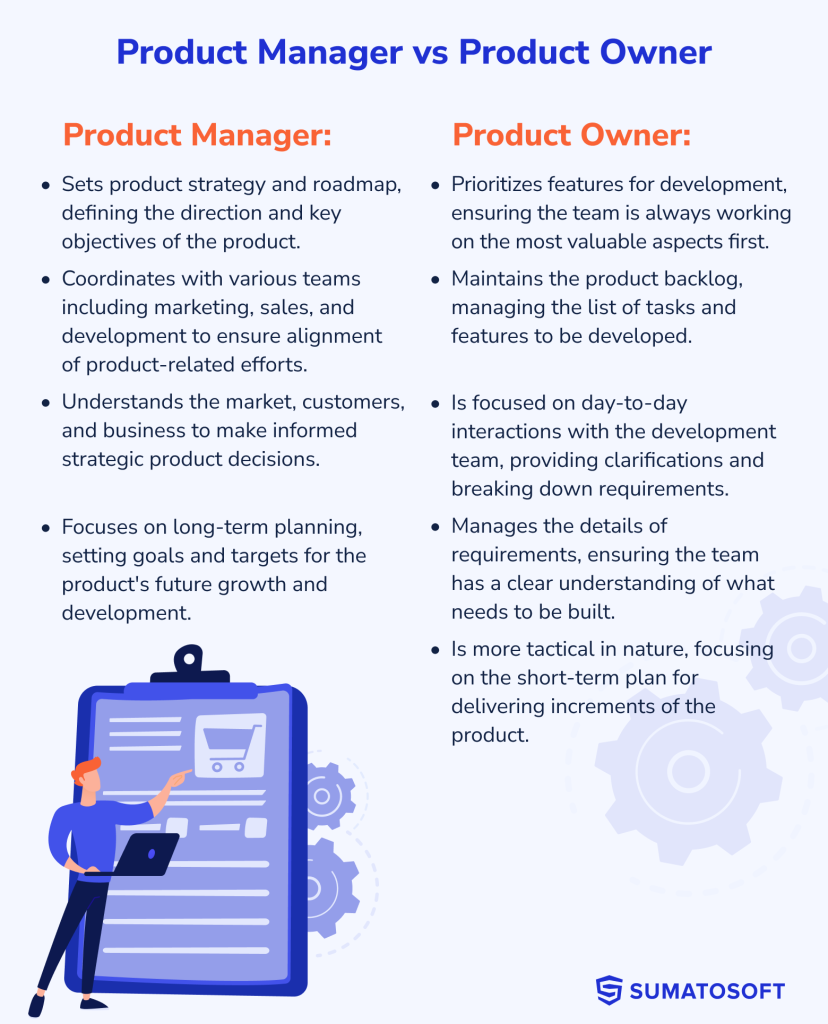
Product Manager:
- Is often a role found in organizations that do not practice Agile development methodologies. In companies that do practice Agile, the Product Manager often has a more outward-facing role.
- Sets the strategy and roadmap for the product or product line.
- Works closely with marketing, sales, and other teams to coordinate product-related efforts.
- Understands the market, the customers, and the business in order to make strategic product decisions.
- Often liaises with stakeholders and upper management to align the product with business goals.
- Focuses more on long-term planning and less on day-to-day operational details.
Product Owner:
- Is a role specifically defined in Scrum, an Agile methodology, but is often present in other Agile settings.
- Represents the customer’s interests and ensures the development team is working on the most valuable features first.
- Is responsible for maintaining and prioritizing the product backlog (the list of all tasks and features), deciding what goes into each sprint (a time-boxed iteration of development).
- Is typically more focused on the day-to-day interaction with the development team and manages the details of the requirements.
- Works closely with both the stakeholders and the development team, acting as a liaison to communicate needs and clarify details.
- Is more tactical in nature, focusing on the short-term plan for delivering increments of the product.
Business Analyst vs Product Owner
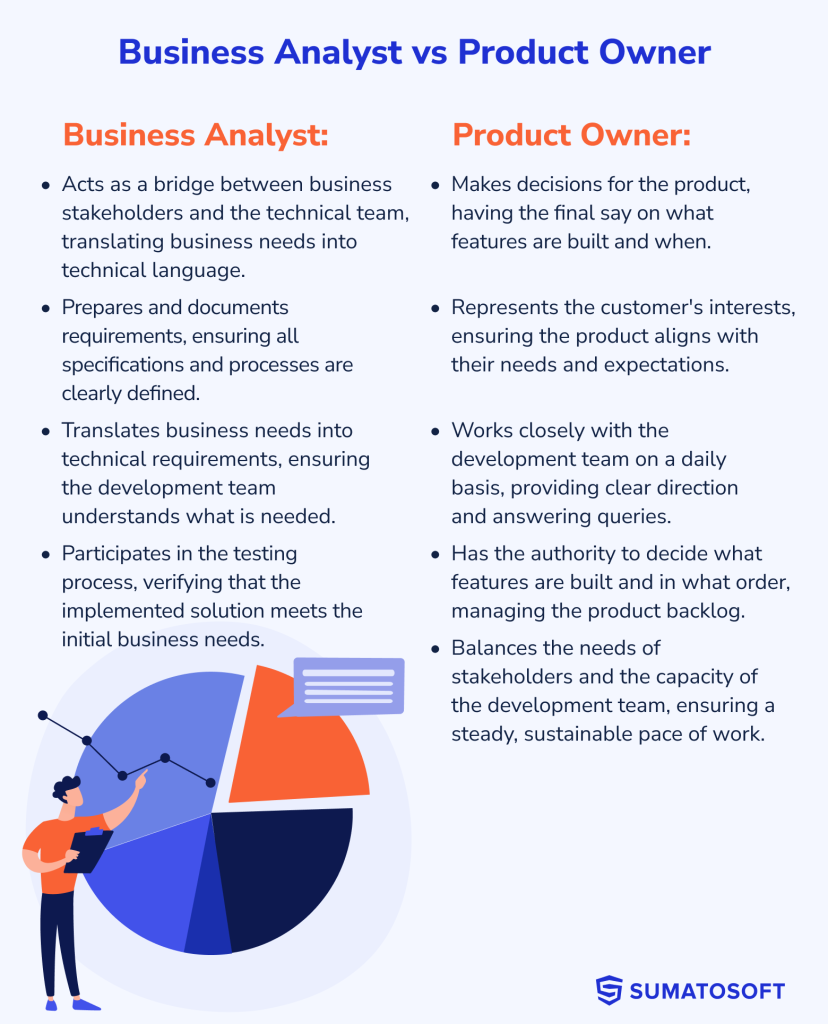
Business Analyst:
- Acts as a bridge between business stakeholders and the technical team, ensuring the latter understands the business requirements.
- Analyzes business processes, systems, and user needs.
- Prepares and documents requirements, specifications, business processes, and recommendations.
- May participate in the testing process, ensuring the solution meets the business needs.
- Works as a translator, converting business language into technical requirements for the development team.
- May not have decision-making power but plays a crucial role in defining what a solution should do.
Product Owner:
- Is a decision-maker for the product, responsible for defining and prioritizing the work the development team does.
- Represents the customer’s interests and ensures the product aligns with market needs.
- Works closely with the development team, often on a daily basis, detailing out requirements and clarifying any confusion.
- Has the authority to decide what features are built and in what order by maintaining the product backlog.
- Balances the needs of the stakeholders and the capacity of the development team to ensure a steady, sustainable pace of work.
- Works more on the tactical level, focusing on how to deliver the product in small increments that provide value.
Scrum Master vs Project Manager
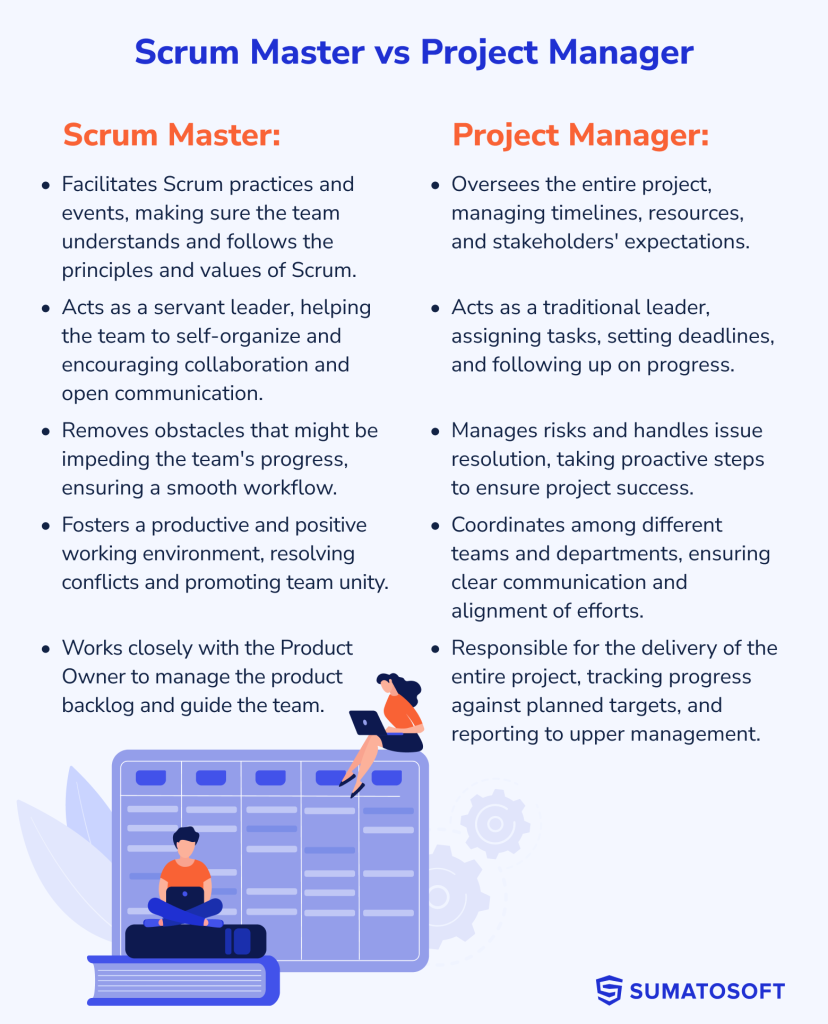
Scrum Master:
- Facilitates Scrum practices and events, making sure the team understands and follows the principles and values of Scrum.
- Acts as a servant leader, helping the team to self-organize and encouraging collaboration and open communication.
- Removes obstacles that might be impeding the team’s progress, ensuring a smooth workflow.
- Fosters a productive and positive working environment, resolving conflicts and promoting team unity.
- Works closely with the Product Owner to manage the product backlog and guide the team.
Project Manager:
- Oversees the entire project, managing timelines, resources, and stakeholders’ expectations.
- Acts as a traditional leader, assigning tasks, setting deadlines, and following up on progress.
- Manages risks and handles issue resolution, taking proactive steps to ensure project success.
- Coordinates among different teams and departments, ensuring clear communication and alignment of efforts.
- Responsible for the delivery of the entire project, tracking progress against planned targets, and reporting to upper management.
Team Sizes: Enterprise, Medium Businesses, Startups
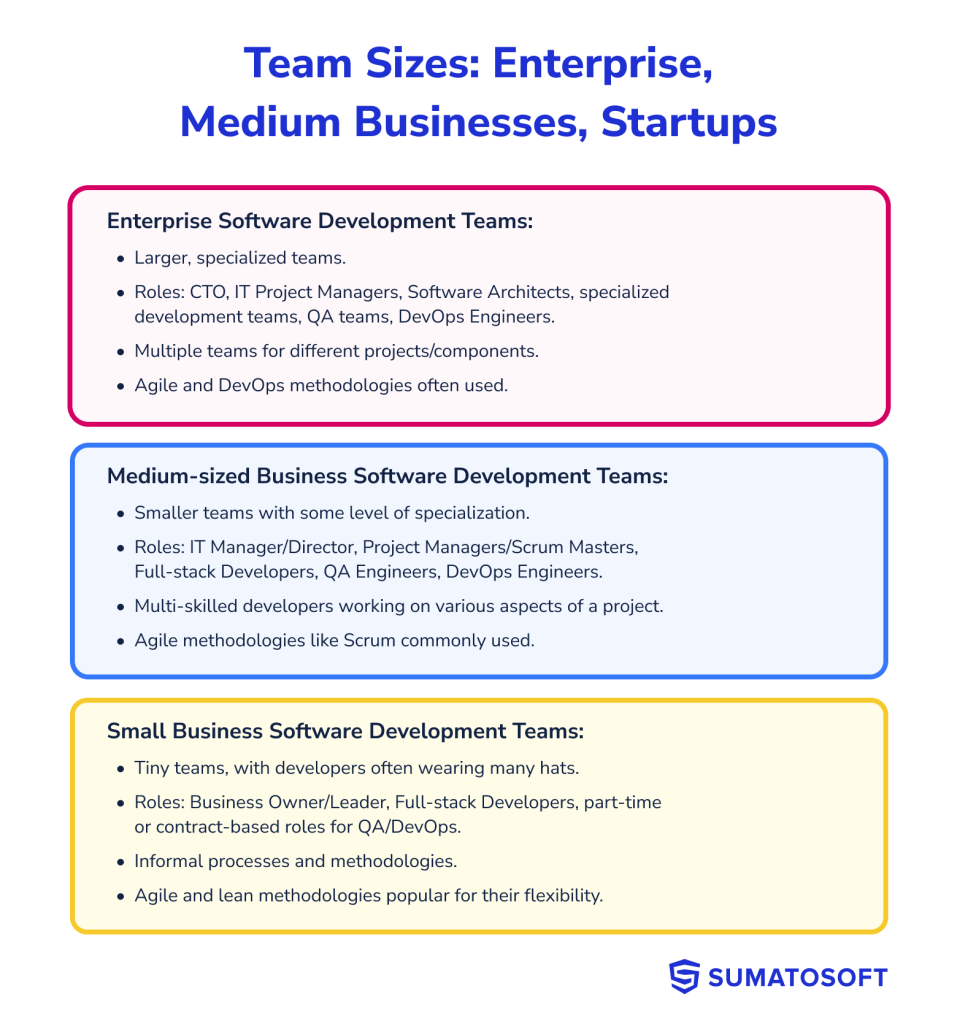
Here’s an overview of typical differences between enterprise, medium-sized, and small businesses:
Enterprise Software Development Teams:
In large enterprises, software development teams tend to be larger and more specialized. Here, you might find roles such as:
- Chief Technology Officer (CTO): This executive role is responsible for the company’s technology strategy.
- IT Project Managers: They manage multiple software development projects.
- Software Architects: They design high-level software solutions.
- Teams for each layer of development (e.g., front-end team, back-end team, database team).
- Quality assurance (QA) teams: They are dedicated to testing and validating software.
- DevOps engineers: They ensure seamless integration between development and operations.
Moreover, enterprises often have multiple teams working on different projects or different components of a large project. They might follow a variety of methodologies, but many have moved towards agile and DevOps approaches for their ability to deliver continuous value.
Medium-sized Business Software Development Teams:
For medium-sized businesses, software development teams are usually smaller but can have a reasonable level of specialization. You might find roles like:
- IT Manager/Director: Overseeing the business’s technology needs.
- Project managers or Scrum Masters: Managing software projects.
- Full-stack developers: These developers can handle both front-end and back-end.
- QA engineers: Testing and validation still play a crucial role.
- DevOps engineers or similar roles: Depending on the business’s needs.
Medium-sized businesses might still have separate teams for different projects, but it’s also common to have multi-skilled developers working on various aspects of a project. Agile methodologies like Scrum are often used here as well.
Small Business Software Development Teams:
In small businesses or startups, teams are often tiny, sometimes composed of just one or two developers. Specialization is usually less here, and team members often wear many hats. Typical roles might include:
- Business Owner/Leader: Often acts as the de facto project manager.
- Full-stack developers: Highly versatile developers who handle all aspects of development.
- Part-time or Contract-based roles: Small businesses might not have a dedicated QA or DevOps role and might outsource these as needed.
In these smaller settings, processes and methodologies can be much more informal. Agile and lean methodologies are popular for their flexibility and focus on delivering customer value quickly.
In all cases, the actual structure and roles can vary widely depending on the business’s specific needs, the complexity of the projects, and the skills of the team members.
How to Choose Between Agile or Traditional Development Methodology
Your project’s size and your department’s needs can be the determining factors in choosing a methodology to move forward with. The traditional software development methodology is usually the best choice for larger companies, especially if they need a proven framework that delivers results on time and within budget. On the other hand, it may be better to use an agile approach if the requirements are less clear, or if the company is smaller and more collaborative.
Similarly, you must assess the risk level when analyzing your goal. In cases where risks are high or requirements are subject to change, an agile framework is a better choice. This is often the case and is reflected by the fact that 71% of US companies choose an agile approach. With shorter sprints, however, issues can be addressed and fixed much faster. With traditional methods, there is little room for error in critical projects, and scope changes are minimal.
If you want to read a more comprehensive overview of software development methodologies, read our guide on how to choose the best software development model.
An Ideal Software Development Team Structure: How It Looks Like
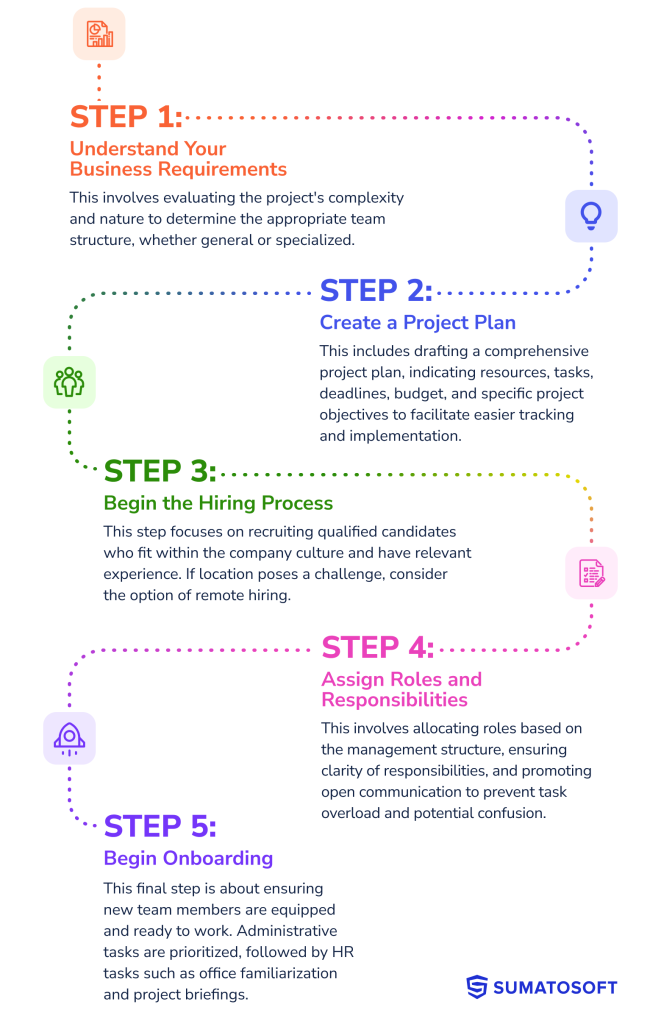
Now that we’re clear on what a software development team does, and how the roles within them function, let’s look at how we can build one of our own.
Every software development team structure is likely to be different spending on the size and needs of the business and the nature and complexity of the software project. Thus, project team roles and responsibilities are not the same as in a product team. To get a better understanding of how to define a software development team structure, we’ve broken down the process into a few simple steps:
Step 1: Understand Your Business Requirements
How complex is the project? Is it a simple POS application for a restaurant, or something more technical? For example, if you’re looking to create a bespoke control panel for your inventory control system, this is likely to require a hybrid or specialist team structure. In contrast, a more straightforward application should be simple enough to build with a more general team structure.
Step 2: Create a Project Plan
Map out a project plan and list all the resources, tasks, and deadlines you need to complete the project — the overall aim being to make your team’s job easier and help them to track their progress. Ensure the plan is comprehensive, and don’t omit any crucial details; especially the project’s budget and due dates. Do you want to prioritize cost or quality? Do you favor a sizable traditionally-structured team, or would you prefer a more streamlined, agile approach? Be honest and open in your decisions — an unclear approach will only make things more difficult in the long run.
Step 3: Begin the Hiring Process
Finding the right people to join your team is a crucial part of the software development team structure. Ensure every candidate has the proper qualifications for the job, will fit in with your company’s culture, and possesses prior experience with similar projects.
Of course, this is often easier said than done — especially if your company’s HQ isn’t located in a major town or city. If this is the case, consider hiring remotely. In days gone by, managing a global team was considered a logistical nightmare, but nowadays, this isn’t the case. Remote’s employer of record service, for example, makes global hiring easy, managing all of the legal and HR aspects of the process and leaving you to focus on recruiting specialized talent.
Step 4: Assign Roles and Responsibilities
Assign roles according to your chosen management structure. Ensure that everyone is clear on their responsibilities, and encourage an open discourse and clear communication from the start. This will prevent individual team members from becoming overloaded, and help to avoid confusion or friction arising among your development team – which could potentially delay or derail the project.
Step 5: Begin Onboarding
Your final step is to make sure your new software development team members are comfortable and ready to get to work. Administrative tasks usually come first: formalities like IT logins and keycard access should be first on the agenda, but ensure that access is only granted to those whose role requires it — known as the principle of least privilege. After these are taken care of, HR tasks such as office familiarization and introductions can take place, before moving on to an in-depth project briefing.
SumatoSoft’s Software Development Team
We are software developers, analysts, managers and testers with about 10 years of expertise in the outsourcing market.
- We provide staff augmentation services – we have a ready-to-go and custom-hired team of software engineers, Scrum Masters, Designers, and QA specialists ready to extend any team’s capacity.
- As well as provide full-cycle custom software development.
We have over 200 successful projects in various industries like eCommerce software, Elearning development, Finance, Real Estate, Logistics software, Travel, and more. Key facts about us are:
- Ruby on Rails development is our key expert area.
- 10 years in the market of software development.
- We work honestly and openly for fair rates.
- No communication barrier since all specialists speak English well.
- 200 custom software solutions.
- 27 countries we worked with.
The SumatoSoft team has built 200 custom software solutions for 27 countries over the last 10 years. Clients are satisfied with our results. 4.8 rating on Clutch and 5.0 rating on Goodfirms prove it. Get in touch!
Conclusion
Software development can be troublesome even at the best of times, but by formulating the right software development team structure, you’ll minimize roadblocks and dramatically raise the chances of your project being delivered successfully, within budget, and by the deadline. If this all sounds a bit too much like hard work though, why not consult our team of experts? Contact us now, and let SumatoSoft’s accomplished team of developers provide your business with the perfect software solution.
Let’s start
If you have any questions, email us info@sumatosoft.com



